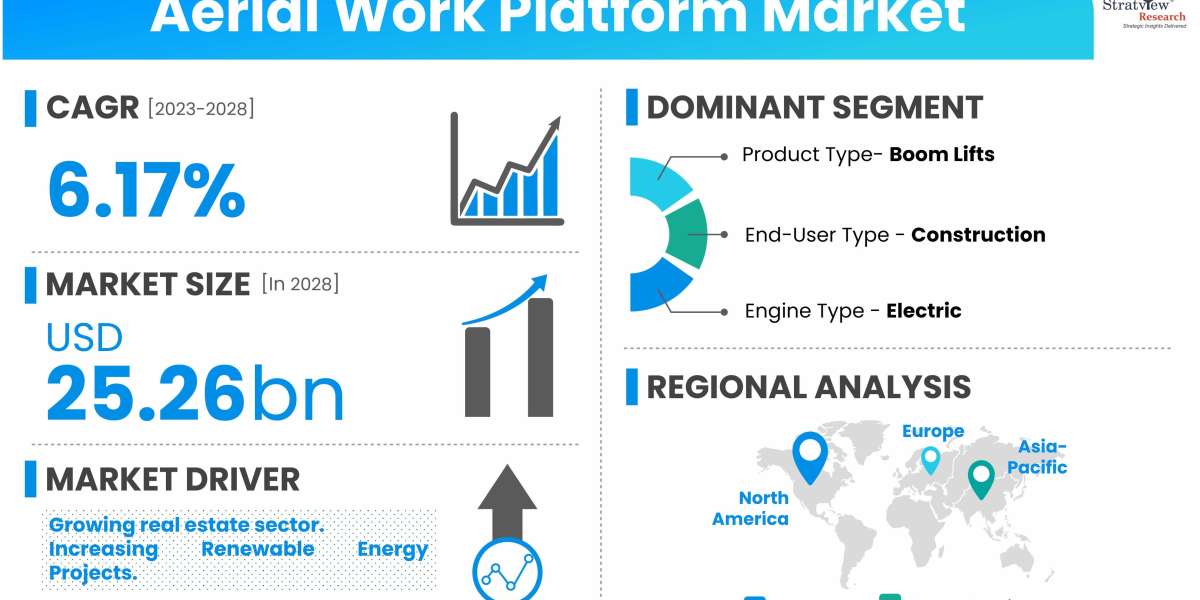The aerial work platform market is experiencing significant growth, driven by the increasing demand for height access equipment in industries like construction, maintenance, and logistics. As companies look for efficient and safer ways to perform work at elevated heights, the aerial work platform market is expanding rapidly. This article explores the leading players in the aerial work platform market and the key factors driving its growth.
According to Stratview Research, the aerial work platform market was estimated at USD 17.59 billion in 2022 and is likely to grow at a CAGR of 6.17% during 2023-2028 to reach USD 25.26 billion in 2028.
Leading Players in the Aerial Work Platform Market
Several global companies dominate the aerial work platform market, offering a range of equipment designed for various industrial applications. JLG Industries, Manitou Group, Terex Corporation, and Haulotte Group are among the key players leading the market. These companies have built strong reputations for offering innovative, high-quality, and reliable platforms, which has helped them secure significant market shares.
JLG Industries, a subsidiary of Oshkosh Corporation, is one of the market leaders, known for its wide range of aerial lifts, including boom lifts, scissor lifts, and vertical mast lifts. Manitou Group has made notable strides in the market with its rough-terrain aerial work platforms, popular in outdoor construction sites. Similarly, Terex Corporation and Haulotte Group continue to expand their presence globally, focusing on product innovation and customer service to remain competitive in the growing market.
What’s Driving the Growth?
- Rising Demand in the Construction Industry
The construction sector remains the largest end-user of aerial work platforms, contributing significantly to market growth. With the ongoing boom in infrastructure development, urbanization, and renovation projects, the need for aerial work platforms has surged. These platforms offer a safe and efficient way for workers to access hard-to-reach areas, whether for installing, maintaining, or repairing structures.
- Technological Advancements
Advances in aerial work platform technology are driving growth in the market. Innovations such as electric-powered lifts, hybrid machines, and remote monitoring systems have made AWPs more environmentally friendly, cost-effective, and easy to operate. These innovations are appealing to industries that prioritize sustainability and efficiency.
- Focus on Safety and Regulations
Stringent safety standards and regulations, particularly in sectors like construction and logistics, are increasing the demand for aerial work platforms. These platforms offer a safer alternative to traditional ladders and scaffolding, reducing the risk of accidents. As safety regulations continue to tighten globally, aerial work platforms are becoming a necessity for companies looking to comply with industry standards.
- Rising Adoption of Rental Services
The growing trend of renting aerial work platforms rather than purchasing them outright is also a key factor driving the market. Companies in industries such as construction, warehousing, and maintenance are increasingly opting for rental services to reduce costs while still having access to the necessary equipment for specific projects.
Conclusion
The aerial work platform market is poised for continued growth, driven by the rising demand from the construction industry, technological advancements, and a greater emphasis on safety. With leading players at the forefront of innovation and expansion, the market is set to remain dynamic and competitive in the coming years. The increasing adoption of aerial work platforms by various industries and the rising popularity of rental services are further contributing to the market’s expanding share.














